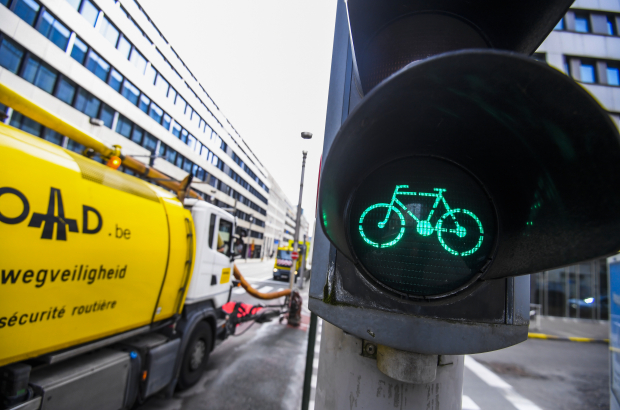- Daily & Weekly newsletters
- Buy & download The Bulletin
- Comment on our articles
Bungled bike path design at Central Station is part of a wider problem, say cyclists
A brand-new elevated cycle path alongside Central Station in Brussels was once again completely blocked by parked cars at the weekend. The situation shows a broader problem in Brussels: new cycling infrastructure is not always bicycle-friendly.
An image showing the parked cars all along the new cycle path circulated around social media at the weekend and brought into view the problem that the city’s authorities face when trying to make the capital more bike-friendly. Cars parked in bicycle lanes are commonplace but the number of cars on the Central Station path was probably a record.
Je zou haast denken dat het een parkeerstrook is. @DAVIDSTEVENS83 ké langsgaan? pic.twitter.com/5KEyDoSFpE
— Heleen Debeuckelaere (@Hdbeucke) November 14, 2021
The illegal parking is not the only problem for the cycle path on the Cantersteen. Cyclists are confused by the design which sees the ochre-coloured path stop and start to allow for a bus stop in between. What a cyclist is supposed to do is unclear. Should they then suddenly swerve back into the road before turning back onto the path when it restarts? Should they dismount? Should they keep on the path – which has suddenly become a pedestrian area – and slalom in between those waiting for buses?
As if that were not enough, the cyclists and pedestrians also regularly come into conflict with each other. After all, the two lanes are at the same height and with its width of 1.80 metres, the bike path is not particularly wide either.
Cycling associations therefore agree that the redevelopment of the Cantersteen is a mistake. "The worst thing is that we also warned about the current problems as soon as we saw the plans," said Florine Cuignet of the cyclists' association GRACQ. "We saw this coming."
"If you want to prevent wild parking you need a real barrier or at least poles," says Cuignet, who also notes that the road itself is far too wide. "The road has to be narrower. Then you can build wider cycle paths. And having a cycle route at the level of the pavement is not the best idea because you invite conflicts between pedestrians and cyclists."
The road had to be wide to allow vehicles that stop shortly in front the station to do so without blocking car traffic, Cuignet recalls. "But you can also organise those kinds of functions differently. In Switzerland, for example, they do this with a central lane where that is possible, while the lanes are much narrower."
The issue of the bus stop was only discovered by the cycling associations after the public inquiry into the project. "Suddenly it turned out that important changes had been made afterwards,” said Florine Cuignet. “On the first version of the plan, that bus stop was moved. The situation there is unreadable and dangerous."
Brussels councillor for mobility Bart Dhondt previously indicated that he was not satisfied with the project for which he himself is responsible. In a recent interview, he passed the ball on to the regional administration for urban planning, which would have been against a wide buffer zone between cycle path and roadway, among other things. However, cycling associations point out that the Dhondt cabinet had dismissed their objections about the project.
Dhondt says that there will still be marking on the cycle path, in the form of bicycle icons. He also wants to contact the urban planning department, to see what form of physical separation is possible between the road and the bike path.
The cabinet of state secretary for urban planning Pascal Smet clarifies that his administration never asked for a narrow buffer zone. "We did ask to keep the pavement as wide as possible. This could also be done by narrowing the road," a spokesperson said.
The bungled cycle path at Central Station is not an isolated case in Brussels, according to cycling associations. "Separated bike lanes that aren't wide enough, that's a recurring problem," Cuignet said. "With a too narrow cycle path, you prevent cyclists from overtaking each other, then everyone just rides in the bicycle traffic jam one after the other. Or you make sure that cyclists ride on the pavement where they can then hit pedestrians."
Dhondt has since pointed out that the police are now trying to rectify the parking situation at Central Station with fines. But putting a police officer on every bike path around the clock is not realistic, say the cycling associations.


















